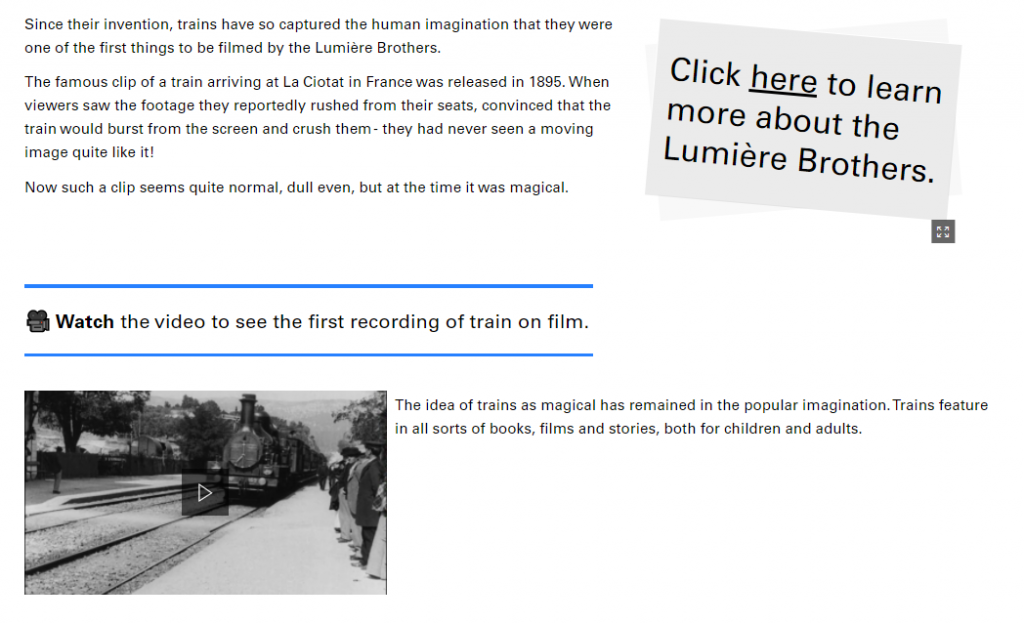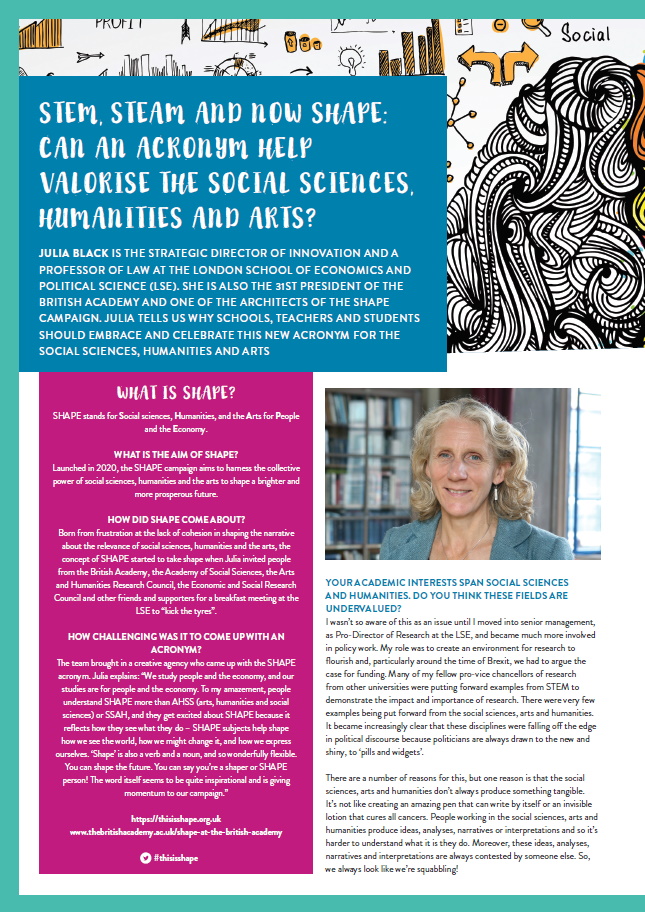STEM, STEAM and now SHAPE: Can an acronym help valorise the social sciences, humanities and arts?
Julia Black is the Strategic Director of Innovation and a professor of law at the London School of Economics and Political Science (LSE). She is also the 31st president of the British Academy and one of the architects of the SHAPE campaign. Julia tells us why schools, teachers and students should embrace and celebrate this new acronym for the social sciences, humanities and arts
SHAPE stands for Social sciences, Humanities, and the Arts for People and the Economy.
WHAT IS THE AIM OF SHAPE?
Launched in 2020, the SHAPE campaign aims to harness the collective power of social sciences, humanities and the arts to shape a brighter and more prosperous future.
HOW DID SHAPE COME ABOUT?
Born from frustration at the lack of cohesion in shaping the narrative about the relevance of social sciences, humanities and the arts, the concept of SHAPE started to take shape when Julia invited people from the British Academy, the Academy of Social Sciences, the Arts and Humanities Research Council, the Economic and Social Research Council and other friends and supporters for a breakfast meeting at the LSE to “kick the tyres”.
HOW CHALLENGING WAS IT TO COME UP WITH AN ACRONYM?
The team brought in a creative agency who came up with the SHAPE acronym. Julia explains: “We study people and the economy, and our studies are for people and the economy. To my amazement, people understand SHAPE more than AHSS (arts, humanities and social sciences) or SSAH, and they get excited about SHAPE because it reflects how they see what they do – SHAPE subjects help shape how we see the world, how we might change it, and how we express ourselves. ‘Shape’ is also a verb and a noun, and so wonderfully flexible. You can shape the future. You can say you’re a shaper or SHAPE person! The word itself seems to be quite inspirational and is giving momentum to our campaign.”
www.thebritishacademy.ac.uk/shape-at-the-british-academy
Twitter: #thisisshape
SHAPE stands for Social sciences, Humanities, and the Arts for People and the Economy.
WHAT IS THE AIM OF SHAPE?
Launched in 2020, the SHAPE campaign aims to harness the collective power of social sciences, humanities and the arts to shape a brighter and more prosperous future.
HOW DID SHAPE COME ABOUT?
Born from frustration at the lack of cohesion in shaping the narrative about the relevance of social sciences, humanities and the arts, the concept of SHAPE started to take shape when Julia invited people from the British Academy, the Academy of Social Sciences, the Arts and Humanities Research Council, the Economic and Social Research Council and other friends and supporters for a breakfast meeting at the LSE to “kick the tyres”.
HOW CHALLENGING WAS IT TO COME UP WITH AN ACRONYM?
The team brought in a creative agency who came up with the SHAPE acronym. Julia explains: “We study people and the economy, and our studies are for people and the economy. To my amazement, people understand SHAPE more than AHSS (arts, humanities and social sciences) or SSAH, and they get excited about SHAPE because it reflects how they see what they do – SHAPE subjects help shape how we see the world, how we might change it, and how we express ourselves. ‘Shape’ is also a verb and a noun, and so wonderfully flexible. You can shape the future. You can say you’re a shaper or SHAPE person! The word itself seems to be quite inspirational and is giving momentum to our campaign.”
www.thebritishacademy.ac.uk/shape-at-the-british-academy
Twitter: #thisisshape
YOUR ACADEMIC INTERESTS SPAN SOCIAL SCIENCES AND HUMANITIES. DO YOU THINK THESE FIELDS ARE UNDERVALUED?
I wasn’t so aware of this as an issue until I moved into senior management, as Pro-Director of Research at the LSE, and became much more involved in policy work. My role was to create an environment for research to flourish and, particularly around the time of Brexit, we had to argue the case for funding. Many of my fellow pro-vice chancellors of research from other universities were putting forward examples from STEM to demonstrate the impact and importance of research. There were very few examples being put forward from the social sciences, arts and humanities. It became increasingly clear that these disciplines were falling off the edge in political discourse because politicians are always drawn to the new and shiny, to ‘pills and widgets’.
There are a number of reasons for this, but one reason is that the social sciences, arts and humanities don’t always produce something tangible. It’s not like creating an amazing pen that can write by itself or an invisible lotion that cures all cancers. People working in the social sciences, arts and humanities produce ideas, analyses, narratives or interpretations and so it’s harder to understand what it is they do. Moreover, these ideas, analyses, narratives and interpretations are always contested by someone else. So, we always look like we’re squabbling!
WHY ARE SHAPE DISCIPLINES JUST AS VALUABLE AS STEM?
When I talk to policy makers, I remind them that government is an exercise in applied social science and it’s important that they make this link. How do you reduce knife crime, for example, or stop domestic abuse, or improve the justice system, the functioning of the NHS, and attainment in schools? These are all social science questions and social scientists have the skills and knowledge to answer them.
Humanities subjects enable us to understand ourselves and others, and the values by which they and we live now and have lived in the past. The world is facing enormous challenges, and having a critical and ethical framework to guide decisions is critical. Furthermore, the value of the arts and culture to our sense of community and well-being is something we have probably all realised through the pandemic. Not only that but healthcare practitioners are now social prescribing, particularly in mental health, and encouraging patients to join a local group or choir, and to appreciate nature, self-expression and creativity, recognising that these activities as essential to well-being.
THERE IS A BIG PUSH FOR STEM IN EDUCATION. WHAT ARE YOUR VIEWS ON THIS?
As long as a child stays in education and training for as long as possible, it’s a big tick in my book. And, as part of this, I’m absolutely all for encouraging kids, and especially girls, to do STEM subjects – but not by disparaging SHAPE disciplines. We have to recognise that you can’t dismiss one group of subjects as ‘worthless’ in an attempt to get kids to choose the other. If we’re going to educate the maximum number of kids for the maximum amount of time, we need to ensure they have a full set of opportunities available to them, both STEM and SHAPE. You can’t say, ‘Don’t do SHAPE subjects because they’re worthless and they won’t take you anywhere’, because that denigrates the whole education enterprise. We should be focusing on ensuring a broad-based curriculum and providing people – young and old – with learning opportunities for as long as possible. There are groups of students for whom STEM subjects don’t appeal. If they’re then told that other subjects aren’t worth doing, even though they might be of interest to them, what options are we giving our young people? What message does that send?
WHERE DOES SHAPE SIT WITH STEM AND STEAM?
SHAPE is not in opposition to STEM; these subjects work incredibly well together. Progress in English is linked to progress in maths. Many studies have shown the wider educational benefits of learning music. Although the questions and focus of STEM and SHAPE subjects may be different, the methodologies for answering them can be similar. And when you’re asking about people’s interaction with nature or the environment or physical space, then you inevitably have crossover between the two.
STEAM is a very specific subset of SHAPE within STEM; it captures the ‘A’ but not the ‘S’ and the ‘H’. STEAM captures the value of integrating art and design with STEM, but not the value of integrating STEM with social sciences and humanities. In contrast, SHAPE enables us to talk about the value of integrating STEM with that much wider set of disciplines focused on people and societies. It’s critical we recognise the value of that wider set of interactions. Getting to net zero, for example, will need new technologies which are well designed, but we also need full scale political, economic, behavioural and system changes too, for which the insights of all SHAPE disciplines are relevant.
IN JUNE, FORMER PRESIDENT OF THE BRITISH ACADEMY SIR DAVID CANNADINE WROTE AN OPEN LETTER TO SHAPE GRADUATES. WHAT WOULD YOU LIKE TO SAY TO SHAPE STUDENTS?
You’ve got skills, knowledge and insights about people and societies, which you can use to address issues that are really important to you. As David said, don’t let anyone do you down. Go and make the most of your unique skills!
ABOUT JULIA

Julia wanted to be a ballet dancer when she was younger before realising, aged 11, that she was never going to be a ballet dancer. After hearing someone talk about the University of Oxford, Julia decided she wanted to go there. She succeeded and studied law. Armed with a first degree in jurisprudence, Julia was offered a training contract at a law firm, but a friend convinced her to continue with her studies and so Julia studied for a DPhil relating to the regulation of the financial services sector.
“My interest in law is not so much about the courts and how to resolve disputes, but more about how the state uses law to get people to change their behaviours,” says Julia. “I was also really interested in companies or any social organisations that were doing socially beneficial activities but without state involvement. The FSC label on loo rolls or tissue boxes, for example, is not a legal system. The FSC has been set up by social groups and works across multiple countries. I’m interested in how and why systems like that work. This is why I’ve ended up traversing the whole social sciences. How do you get people, social groups and organisations to change what they do so that it is socially beneficial? And why do some do that themselves? And do you maintain that change over time? These are questions I still don’t know the answer to.”
WHAT TEACHERS AND SCHOOLS SHOULD KNOW ABOUT SHAPE
A group of SHAPE collaborators ran a pilot project in eight schools across the UK’s four nations, introducing SHAPE to a cohort of 12-14-year-olds and to a group of 20 teachers from across the SHAPE disciplines. The aim of the pilot was to increase the visibility of SHAPE subjects, to demonstrate the relevance of SHAPE subjects and to encourage a personal connection with SHAPE subjects.
Working with organisations experienced in object-based learning, such as museums and universities, the team devised a suite of three workshops and an extensive teacher training programme. The learner workshops focused on three everyday objects – trains, masks and shoes – and encouraged students to explore them from the perspective of multiple SHAPE disciplines, as well as to consider the links between SHAPE subjects and with STEM. The teacher training supported teachers to consider their own positionality towards SHAPE and to facilitate ‘SHAPE’ thinking amongst their learners.
Why trains, masks and shoes? Trains, masks and shoes are everyday objects that are within the lived ecosystems of the learners’ life experiences. The intention is to encourage an understanding that no object is neutral and that we need to interrogate the everyday, every day, as a way to better understand the world. Take trains, for example. How do you say train in different languages? What is the etymology of train? When were trains invented and how have they evolved over time? What are trains’ role in literature and film? What are the environmental and economic issues surrounding HS2? Once questions like these had been explored, pupils were given guidance on how to employ methodologies used in the SHAPE disciplines to take on the role of a SHAPE professional and create a product (a survey, a vlog, a story or a business pitch).
As a follow on to this pilot project, the team is now looking into developing a series of creative resources that will enable teachers, students and carers to see where SHAPE subjects might lead in terms of careers.
PROJECT EVALUATION
Outcomes from the pilot project confirmed that this approach positively influenced teacher and learner attitudes towards SHAPE subjects. The external evaluation found that the workshops increased learner interest in learning about SHAPE subjects in school, with 67% of learners saying they were ‘much more’ or ‘a little more’ interested in learning about SHAPE subjects after taking part. The experience also impacted on intentions around post-16 qualifications, with 58% saying they are ‘much more’ or ‘a little more’ likely to take SHAPE subjects. The project supported learners to think more broadly about SHAPE careers: previously “they [SHAPE subjects] felt like hobbies to enjoy but not careers. Now I’m thinking a little more about these subjects and considering my strengths within them.” (Learner feedback.)
Moreover, through the pilot project, teachers benefited from collaborating with other teachers from other nations and from a broad range of subject areas: drama, art, business studies, history, languages, maths, geography, etc. Many teachers commented that they were not previously aware of object-based learning and that they enjoyed learning a new skill and would continue to develop this facilitative SHAPE approach.
Teachers were challenged to look beyond their own discipline and skills, thinking in more interdisciplinary and cross-curricular way. Julia explains, “Bringing teachers together from across a range of disciplines to teach the same materials was a fascinating experience. Teachers varied in their comfort levels when asked to teach ‘beyond their subject area’ and to think in interdisciplinary ways. Teachers learned from one another’s skills, broadening their own SHAPE perspectives and skills.”
For more information, contact: [email protected]
The pilot project was delivered online. These screenshots are of some of the SHAPE team’s education resources relating to trains.





